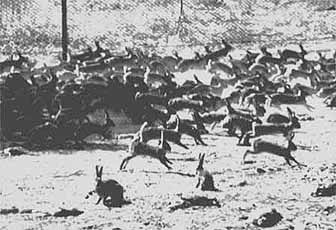 | Alien Species in Hawaii Information Project, from www.hear.org. ("hawaiian ecosystems at risk") C |
 | DAISIE, "Delivering Alien Invasive Species Inventories for Europe", with a database section. C |
 | Database of Non-native species occurring in the UK Overseas Territories, Excel spreadsheet in ZIP archive, from JNCC, 446 kB C |
 | Global Invasive Species Database, also see Hundred of the World's Worst Invasive Alien Species C |
 | The Great Reshuffling. Human Dimensions of Invasive Alien Species,, edited by Jeffrey A. McNeely. IUCN Biodiversity Policy Coordination Division, 2001; pdf document, downloads in 10 minutes. C |
 | Institute for Biological invasions, webpage by Todd Campbell. A very rich offer of links and references, but no maintenance after 1.10.05. One of those sites that went out of steam. C |
 | Introduced Species in the British Isles, a private-run site, not bad. C |
 | Invasive Alien Species Issues, by Keizi Kiritani; proceedings from a Japanese symposium "Forest Insect Population Dynamics and Host Influences”. A good general approach to the Japanese situation with one section "Species Interchange between Japan and the USA". C |
 | Invasive Non-Native Species, background and issues for Congress. Updated 25.11.02. C |
 | Invasive Species in Ireland Because of its past as a British colony, as well as for its mild winter climate, Ireland was kind of a laboratory for "acclimatisation"-minded British land-owners in the 19th century. C |
 | Invasive Species in Ireland, report prepared by Quercus, Queen's University, Belfast. Here is a quotation giving the "invasive species problem" in a nutshell (roach is an introduction to Ireland, i guess St Patrick lies behind):
Roach can have severe ecological consequences, particularly when lakes become enriched from mesotrophic to eutrophic conditions. Their ability to reach a large biomass and heavily graze zooplankton can exacerbate the algal blooms associated with nutrient enrichment in lakes. They can apparently accelerate the switch from clear water mesotrophy to a turbid water eutrophic state, effectively altering their environment to their own requirements. C |
 | Invasive Alien Species in Northern Ireland, from National Museums Northern Ireland. C |
 | Invasive Species Publications, from the Australian Dept. of Environment. C |
 | National Invasive Species Information Center, from the US Dept. of Agriculture. C |
 | NOBANIS, North European and Baltic Network on Invasive Alien Species, offers a database in English and 59 factsheets on invasive aliens. C |
 | Regional Biological Invasions Centre, last update 16.8.06. It's hosted or produced by The Russian Academy of Sciences, and a.o. EU-financed, so there probably is some cold war going on. [CP] C |
 | Acclimatisation, by Alfred Russel Wallace, from the Ninth Edition of the Encyclopædia Britannica in 1875. C |
 | Acclimatisation, from Te Ara Encyclopedia of New Zealand. C |
 | Zeitschrift für Acclimatisation, (1858-1874) from Natural Museum Library, London. Just wonderful to find this; here a quotation, twelve years before the Franco-German War:
While speaking of France, I must mention a collection, that took place during our last meeting as a contribution to the erection of a memorial for Etienne Geoffroy Saint Hilaire, amounting to 40 Francs. I have passed this money on to Paris, and I have the pleasure, to express the thanks of the committee responsible to the givers. What Etienne Geoffroy St. Hilaire has meant to the world, is well known to anyone, who ever took a work of natural science in his hands. C |
 | European Red Fox, from Australian Dept of the Environment. With a pdf file. C |
 | Feral Feasts, Foxes. With data concerning Tasmania. C |
 | The Fox Website, from The Mammal Group, University of Bristol. C |
 | The Fox: Australia's worst Predator, factsheet from "Invasive Animals CRC". C |
 | Improving Fox Management Strategies, pdf document from New South Wales Dept of Primary Industries, 206 pages. C |
 | The Fox in Tasmania, from Parks and Wildlife Service Tasmania. C |
 | Ecological effects of Spartina anglica on the macro-invertebrate infauna of the mud-flats at Bull Islands, Dublin Bay, Ireland, by M. J. McCorry & M. L. Otte, Web Ecology 2: 71-73. As pdf document.. C |
 | Global Invasive Species Database, Spartina anglica. Compiled by Mark Hammond. C |
 | JNCC, Spartina anglica Here again the invasive species problem in a nutshell: "The smooth cord-grass Spartina alterniflora was introduced from the east coast of North America to Southampton Water prior to 1870 and was first found on mudflats near Hythe (Stapf 1913). Its subsequent crossing with the native small cord-grass S. maritima resulted in the appearance of a fertile amphidiploid, the common cord-grass S. anglica (and in the sterile hybrid S. townsendii which preceded it)." C |
 | The San Francisco Estuary Invasive Spartina Project, "left unchecked, invasive Spartina threatens to invade 69,402 acres of the San Francisco Estuary". C |
 | Spartina Salt Marshes, a US marine biology site, pics from the New York area. C |
 | Aliens, The Study of Algal Invasions on European Shores, a EU-financed projects, the website offers ten "workpackages". C |
 | Atlas of Exotic Species in the Mediterranean, three subdivisions: fishes, crustaceans, molluscs, from the Mediterranean Science Commission. C |
 | Ballast Water Management to Combat Invasive Species, a CRS-report for Congress, updated 20.7.07. "Reflecting the scope of the
problem, the San Francisco Bay-Delta ecosystem is considered to be one of the most disrupted aquatic ecosystems in the United States, with colonization by more than 230 non-native species." C |
 | Dynamic Map of Zebra Mussel Distribution, from nationalatlas.gov, a very fine resource. C |
 | Mnemiopsis leidyi (American comb jelly), by Tamara A. Shiganova & Vadim E. Panov, from Regional Biological Invasion Center. Last updated 15.1.2003. C |
 | USGS: Zebra Mussel factsheet, from Great Lakes Science Center. And Zebra Mussels Cause Economic and Ecological Problems in the Great Lakes from the same source. C |
 | Zebra and Quagga Mussel Sightings Distribution, from USGS, 25.11.08. C |





























